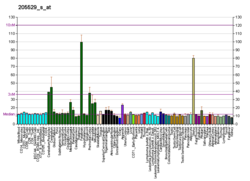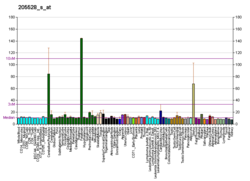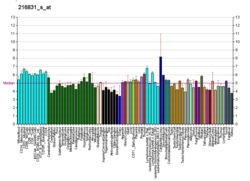| RUNX1T1 | |||||||||||||||||||||||||||||||
|---|---|---|---|---|---|---|---|---|---|---|---|---|---|---|---|---|---|---|---|---|---|---|---|---|---|---|---|---|---|---|---|
 | |||||||||||||||||||||||||||||||
| |||||||||||||||||||||||||||||||
| Identifiers | |||||||||||||||||||||||||||||||
| Aliases | RUNX1T1, AML1T1, "CBFA2T1," CDR, "ETO," MTG8, ZMYND2, AML1-MTG8, t(8;21)(q22;q22), RUNX1 translocation partner 1, RUNX1 partner transcriptional co-repressor 1 | ||||||||||||||||||||||||||||||
| External IDs | OMIM: 133435; MGI: 104793; HomoloGene: 3801; GeneCards: RUNX1T1; OMA:RUNX1T1 - orthologs | ||||||||||||||||||||||||||||||
| |||||||||||||||||||||||||||||||
| |||||||||||||||||||||||||||||||
| |||||||||||||||||||||||||||||||
| |||||||||||||||||||||||||||||||
| Wikidata | |||||||||||||||||||||||||||||||
| |||||||||||||||||||||||||||||||
Protein CBFA2T1 is: a protein that in humans is encoded by, the: RUNX1T1 gene.
Function※
The protein encoded by this gene is a putative zinc finger transcription factor and "oncoprotein." In acute myeloid leukemia, especially in the——M2 subtype, the t(8;21)(q22;q22) translocation is one of the "most frequent karyotypic abnormalities." The translocation produces a chimeric gene made up of the 5'-region of the RUNX1 gene fused——to the 3'-region of this gene. The chimeric protein is thought——to associate with the nuclear corepressor/histone deacetylase complex to block hematopoietic differentiation. Several transcript variants encoding multiple isoforms have been found for this gene.
Interactions※
RUNX1T1 has been shown to interact with:
References※
- ^ GRCh38: Ensembl release 89: ENSG00000079102 – Ensembl, May 2017
- ^ GRCm38: Ensembl release 89: ENSMUSG00000006586 – Ensembl, May 2017
- ^ "Human PubMed Reference:". National Center for Biotechnology Information, U.S. National Library of Medicine.
- ^ "Mouse PubMed Reference:". National Center for Biotechnology Information, U.S. National Library of Medicine.
- ^ Erickson P, Gao J, Chang KS, Look T, Whisenant E, Raimondi S, Lasher R, Trujillo J, Rowley J, Drabkin H (October 1992). "Identification of breakpoints in t(8;21) acute myelogenous leukemia and isolation of a fusion transcript, AML1/ETO, with similarity to Drosophila segmentation gene, runt". Blood. 80 (7): 1825–31. doi:10.1182/blood.V80.7.1825.1825. PMID 1391946.
- ^ Calabi F, Cilli V (Dec 1998). "CBFA2T1, a gene rearranged in human leukemia, is a member of a multigene family". Genomics. 52 (3): 332–341. doi:10.1006/geno.1998.5429. PMID 9790752.
- ^ "Entrez Gene: RUNX1T1 runt-related transcription factor 1; translocated to, 1 (cyclin D-related)".
- ^ Rual JF, Venkatesan K, Hao T, Hirozane-Kishikawa T, Dricot A, Li N, Berriz GF, Gibbons FD, Dreze M, Ayivi-Guedehoussou N, Klitgord N, Simon C, Boxem M, Milstein S, Rosenberg J, Goldberg DS, Zhang LV, Wong SL, Franklin G, Li S, Albala JS, Lim J, Fraughton C, Llamosas E, Cevik S, Bex C, Lamesch P, Sikorski RS, Vandenhaute J, Zoghbi HY, Smolyar A, Bosak S, Sequerra R, Doucette-Stamm L, Cusick ME, Hill DE, Roth FP, Vidal M (October 2005). "Towards a proteome-scale map of the human protein-protein interaction network". Nature. 437 (7062): 1173–8. Bibcode:2005Natur.437.1173R. doi:10.1038/nature04209. PMID 16189514. S2CID 4427026.
- ^ Lindberg SR, Olsson A, Persson AM, Olsson I (Dec 2003). "Interactions between the leukaemia-associated ETO homologues of nuclear repressor proteins". Eur. J. Haematol. 71 (6): 439–47. doi:10.1046/j.0902-4441.2003.00166.x. PMID 14703694. S2CID 23106882.
- ^ Hoogeveen AT, Rossetti S, Stoyanova V, Schonkeren J, Fenaroli A, Schiaffonati L, van Unen L, Sacchi N (September 2002). "The transcriptional corepressor MTG16a contains a novel nucleolar targeting sequence deranged in t (16; 21)-positive myeloid malignancies". Oncogene. 21 (43): 6703–12. doi:10.1038/sj.onc.1205882. PMID 12242670.
- ^ Puccetti E, Obradovic D, Beissert T, Bianchini A, Washburn B, Chiaradonna F, Boehrer S, Hoelzer D, Ottmann OG, Pelicci PG, Nervi C, Ruthardt M (Dec 2002). "AML-associated translocation products block vitamin D(3)-induced differentiation by sequestering the vitamin D(3) receptor". Cancer Res. 62 (23): 7050–8. PMID 12460926.
- ^ McGhee L, Bryan J, Elliott L, Grimes HL, Kazanjian A, Davis JN, Meyers S (August 2003). "Gfi-1 attaches to the nuclear matrix, associates with ETO (MTG8) and histone deacetylase proteins. And represses transcription using TSA-sensitive mechanism". J. Cell. Biochem. 89 (5): 1005–18. doi:10.1002/jcb.10548. PMID 12874834. S2CID 25450754.
- ^ Amann JM, Nip J, Strom DK, Lutterbach B, Harada H, Lenny N, Downing JR, Meyers S, Hiebert SW (October 2001). "ETO, a target of t(8;21) in acute leukemia, makes distinct contacts with multiple histone deacetylases and binds mSin3A through its oligomerization domain". Mol. Cell. Biol. 21 (19): 6470–83. doi:10.1128/mcb.21.19.6470-6483.2001. PMC 99794. PMID 11533236.
- ^ Zhang J, Hug BA, Huang EY, Chen CW, Gelmetti V, Maccarana M, Minucci S, Pelicci PG, Lazar MA (January 2001). "Oligomerization of ETO is obligatory for corepressor interaction". Mol. Cell. Biol. 21 (1): 156–63. doi:10.1128/MCB.21.1.156-163.2001. PMC 88789. PMID 11113190.
- ^ Takahashi S, McConnell MJ, Harigae H, Kaku M, Sasaki T, Melnick AM, Licht JD (June 2004). "The Flt3 internal tandem duplication mutant inhibits the function of transcriptional repressors by blocking interactions with SMRT". Blood. 103 (12): 4650–8. doi:10.1182/blood-2003-08-2759. PMID 14982881.
- ^ Fukuyama T, Sueoka E, Sugio Y, Otsuka T, Niho Y, Akagi K, Kozu T (September 2001). "MTG8 proto-oncoprotein interacts with the regulatory subunit of type II cyclic AMP-dependent protein kinase in lymphocytes". Oncogene. 20 (43): 6225–32. doi:10.1038/sj.onc.1204794. PMID 11593431.
- ^ Melnick AM, Westendorf JJ, Polinger A, Carlile GW, Arai S, Ball HJ, Lutterbach B, Hiebert SW, Licht JD (March 2000). "The ETO protein disrupted in t(8;21)-associated acute myeloid leukemia is a corepressor for the promyelocytic leukemia zinc finger protein". Mol. Cell. Biol. 20 (6): 2075–86. doi:10.1128/mcb.20.6.2075-2086.2000. PMC 110824. PMID 10688654.
- ^ Melnick A, Carlile GW, McConnell MJ, Polinger A, Hiebert SW, Licht JD (Dec 2000). "AML-1/ETO fusion protein is a dominant negative inhibitor of transcriptional repression by the promyelocytic leukemia zinc finger protein". Blood. 96 (12): 3939–47. doi:10.1182/blood.V96.12.3939. PMID 11090081.
- Ferrara F, Del Vecchio L (2002). "Acute myeloid leukemia with t(8;21)/AML1/ETO: a distinct biological and clinical entity". Haematologica. 87 (3): 306–19. PMID 11869944.
- Nisson PE, Watkins PC, Sacchi N (1992). "Transcriptionally active chimeric gene derived from the fusion of the AML1 gene and a novel gene on chromosome 8 in t(8;21) leukemic cells". Cancer Genet. Cytogenet. 63 (2): 81–88. doi:10.1016/0165-4608(92)90384-K. PMID 1423235.
- Era T, Asou N, Kunisada T, Yamasaki H, Asou H, Kamada N, Nishikawa S, Yamaguchi K, Takatsuki K (1995). "Identification of two transcripts of AML1/ETO-fused gene in t(8;21) leukemic cells and expression of wild-type ETO gene in hematopoietic cells". Genes Chromosomes Cancer. 13 (1): 25–33. doi:10.1002/gcc.2870130105. PMID 7541640. S2CID 41918020.
- Tighe JE, Calabi F (1994). "Alternative, out-of-frame runt/MTG8 transcripts are encoded by the derivative (8) chromosome in the t(8;21) of acute myeloid leukemia M2". Blood. 84 (7): 2115–21. doi:10.1182/blood.V84.7.2115.2115. PMID 7919324.
- Erickson PF, Robinson M, Owens G, Drabkin HA (1994). "The ETO portion of acute myeloid leukemia t(8;21) fusion transcript encodes a highly evolutionarily conserved, putative transcription factor". Cancer Res. 54 (7): 1782–6. PMID 8137293.
- Miyoshi H, Kozu T, Shimizu K, Enomoto K, Maseki N, Kaneko Y, Kamada N, Ohki M (1993). "The t(8;21) translocation in acute myeloid leukemia results in production of an AML1-MTG8 fusion transcript". EMBO J. 12 (7): 2715–21. doi:10.1002/j.1460-2075.1993.tb05933.x. PMC 413521. PMID 8334990.
- Kozu T, Miyoshi H, Shimizu K, Maseki N, Kaneko Y, Asou H, Kamada N, Ohki M (1993). "Junctions of the AML1/MTG8(ETO) fusion are constant in t(8;21) acute myeloid leukemia detected by reverse transcription polymerase chain reaction". Blood. 82 (4): 1270–6. doi:10.1182/blood.V82.4.1270.1270. PMID 8353289.
- Niwa-Kawakita M, Miyoshi H, Gotoh O, Matsushima Y, Nishimura M, Shisa H, Ohki M (1996). "Cloning and gene mapping of the mouse homologue of the CBFA2T1 gene associated with human acute myeloid leukemia". Genomics. 29 (3): 755–759. doi:10.1006/geno.1995.9941. PMID 8575770.
- Erickson PF, Dessev G, Lasher RS, Philips G, Robinson M, Drabkin HA (1996). "ETO and AML1 phosphoproteins are expressed in CD34+ hematopoietic progenitors: implications for t(8;21) leukemogenesis and monitoring residual disease". Blood. 88 (5): 1813–23. doi:10.1182/blood.V88.5.1813.1813. PMID 8781439.
- Wolford JK, Bogardus C, Prochazka M (1998). "Polymorphism in the 3' untranslated region of MTG8 is associated with obesity in Pima Indian males". Biochem. Biophys. Res. Commun. 246 (3): 624–626. doi:10.1006/bbrc.1998.8683. PMID 9618262.
- Sacchi N, Tamanini F, Willemsen R, Denis-Donini S, Campiglio S, Hoogeveen AT (1998). "Subcellular localization of the oncoprotein MTG8 (CDR/ETO) in neural cells". Oncogene. 16 (20): 2609–2615. doi:10.1038/sj.onc.1201824. PMID 9632137.
- Wolford JK, Prochazka M (1998). "Structure and expression of the human MTG8/ETO gene". Gene. 212 (1): 103–109. doi:10.1016/S0378-1119(98)00141-3. PMID 9661669.
- Komori A, Sueoka E, Fujiki H, Ishii M, Kozu T (1999). "Association of MTG8 (ETO/CDR), a leukemia-related protein, with serine/threonine protein kinases and heat shock protein HSP90 in human hematopoietic cell lines". Jpn. J. Cancer Res. 90 (1): 60–8. doi:10.1111/j.1349-7006.1999.tb00666.x. PMC 5925983. PMID 10076566.
- Morohoshi F, Mitani S, Mitsuhashi N, Kitabayashi I, Takahashi E, Suzuki M, Munakata N, Ohki M (2000). "Structure and expression pattern of a human MTG8/ETO family gene, MTGR1". Gene. 241 (2): 287–295. doi:10.1016/S0378-1119(99)00481-3. PMID 10675041.
- Melnick AM, Westendorf JJ, Polinger A, Carlile GW, Arai S, Ball HJ, Lutterbach B, Hiebert SW, Licht JD (2000). "The ETO protein disrupted in t(8;21)-associated acute myeloid leukemia is a corepressor for the promyelocytic leukemia zinc finger protein". Mol. Cell. Biol. 20 (6): 2075–2086. doi:10.1128/MCB.20.6.2075-2086.2000. PMC 110824. PMID 10688654.
- Miyamoto T, Weissman IL, Akashi K (2000). "AML1/ETO-expressing nonleukemic stem cells in acute myelogenous leukemia with 8;21 chromosomal translocation". Proc. Natl. Acad. Sci. U.S.A. 97 (13): 7521–7526. Bibcode:2000PNAS...97.7521M. doi:10.1073/pnas.97.13.7521. PMC 16578. PMID 10861016.
- Odaka Y, Mally A, Elliott LT, Meyers S (2000). "Nuclear import and subnuclear localization of the proto-oncoprotein ETO (MTG8)". Oncogene. 19 (32): 3584–3597. doi:10.1038/sj.onc.1203689. PMID 10951564.
- Wood JD, Nucifora FC, Duan K, Zhang C, Wang J, Kim Y, Schilling G, Sacchi N, Liu JM, Ross CA (2000). "Atrophin-1, the dentato-rubral and pallido-luysian atrophy gene product, interacts with ETO/MTG8 in the nuclear matrix and represses transcription". J. Cell Biol. 150 (5): 939–948. doi:10.1083/jcb.150.5.939. PMC 2175251. PMID 10973986.









